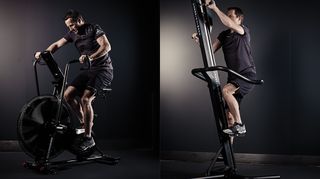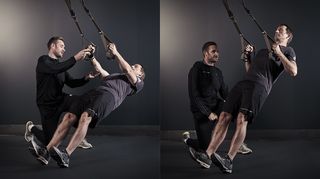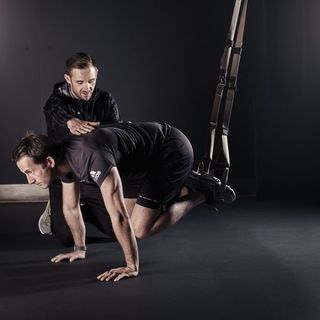Ben Ainslie: Coming To America’s
He’s already one of Britain’s greatest ever Olympians, but now Ben Ainslie is training to take on sailing’s greatest test

Photography: Glen Burrows
For a lot of athletes, hitting 40 with a quartet of Olympic gold medals – earned over two decades’ worth of dominance in their chosen sport – as well as a knighthood might be a good time to call it a day. Perhaps get a TV presenting gig, maybe put on a bit of comfort weight. For Ben Ainslie, it’s time to train harder than ever.
“The physical requirements across the sport have increased immeasurably since I started competing,” says Ainslie, who began his Olympic career back in 1996 in sailing’s Laser class, before moving up to the more physically demanding Finn. “The Finn was always physical, but some of the changes in the rules about how you can sail the boat and how physical you’re allowed to be, alongside new techniques that became incredibly important… it became about aerobic capacity and bursts of power.”
And now that he’s retired from Olympic competition, there’s no rest for Ainslie, who needs to stay lean, strong and mentally alert for a new challenge in the form of the America’s Cup. And, yes, it’s a hell of a challenge.
Sailing’s most prestigious prize is also the world’s oldest international sporting trophy – it was first contested in 1851 – and it’s also the one most stacked in favour of the defending champions, who get to choose the venue and the rules of engagement. They also get a guaranteed place in the knockout round robin, while the other teams compete in four racing events called the America’s Cup World Series to earn a spot.
Ainslie first formed the Land Rover BAR team to challenge for the Cup in 2012, and – after victory in the 2015-16 World Series followed by a semi-final defeat in the qualifiers for the 2017 edition – they’re now prepping for the 2021 series. And, though the “grinders” (the crew members who operate the winches to raise the sails and move the boom) have the most physical job on their multi-man squad, Ainslie’s still leading by example in the gym. While he admits his role helming and steering isn’t as physically demanding, it has its own tough requirements such as moving about quickly from side to side – and, as the 41-year-old who carried the GB flag at the 2012 closing ceremony points out, serious mental focus over long periods.
While old-school Cups were cerebral, endurance-heavy events punctuated by furious bursts of all-out effort, the modern race consists of 15- to 20-minute sprints with a premium on nonstop power-endurance grinding. There’s also weight to consider. Rules limit the crew’s total mass, typically making for an average weight of 87.5kg, but in most teams the helmsman and trimmer will be lighter, allowing the grinders to pack on muscle.
Get the Coach Newsletter
Sign up for workout ideas, training advice, reviews of the latest gear and more.
It’s a stern enough physical and mental challenge even without the formula one-level organisation, strategy and logistics to consider. So how is Ainslie coping? Well, as we found out, it’s not all (ahem) plain sailing…
You’re not just one of Britain’s most decorated Olympians, but one of the most long-lasting. How have you stayed on top of your game for this long?
I guess I’m lucky in sailing, in that it’s quite a diverse sport – there’s always another challenge to go for, to expand your skillset. When I look at sports like rowing and swimming, as we all know there’s the sheer intensity of training, but also the commitment and continuity – when you look at guys like Steve Redgrave or Bradley Wiggins or Chris Hoy, I’m in awe of them for what they’ve achieved and what they’ve gone through to do it. Sir Steve is my Olympic hero, really.
Do you Olympic heroes all talk to each other?
Funny story: I was invited on This Is Your Life when Steve Redgrave was on it, and introduced as one of his teammates on Team GB – and it was pretty clear that he didn’t have a clue who I was [the episode aired in 1996]. But yes, I’ve been very lucky to get to know Steve reasonably well – he’s always been a mentor over the years and a big support. I chat to Matthew Pinsent as well, and then of course guys like Chris Hoy and Bradley Wiggins. What really sets them apart is dedication and applying themselves. There are talented people everywhere, but to get to the top and stay there takes dedication and application.
What’s the best bit of advice any Redgrave’s given you?
At London 2012, there was a lot going on around the hype, and he would just say, “You’ve got to keep doing what you do – don’t get distracted by things that don’t matter”. It’s very basic advice but sometimes that’s what you need.
Agreed. Just how physical is the America’s Cup these days?
Well, in the America’s Cup the intensity’s gone up because of rule changes and the dynamics of the boat. In the last cup the grinders were very involved in creating the oil pressures, and they were working nonstop for a 25-minute race. In my role helming and steering the boat it’s not as physically demanding, but I need to be able to move about quickly from side to side, and also mentally focus at a high level for long periods of time. Decision-making under pressure is very different from being able to sit down and think about it, too.
So what does your training look like?
The more aerobic fitness and endurance I have the better. I really like running, but I haven’t been able to run for three or four years. I’m keen on cycling these days – in the last six months I haven’t done as much as I’d like, but I do enjoy it. When I was based in San Francisco for 2013 I got really into it. I moved to the Isle of Wight in 2016 with my family, so that’s an opportunity to get into it again.
A lot of my other training is focused around rehab and prehab for injuries I’ve had – I do a lot of TRX training. It’s about trying to free up my upper body in particular. That combines with the aerobic work – for instance, the Versaclimber allows me to take impact off while I’m training and focus on the right muscles.

And, of course, you have to watch your weight…
Well, I’m used to that from my whole career. The ideal weight for the Laser class, for instance, is about 80kg, then I switched to Finn where the average weight is about 100kg, then I finished with that in 2012 and lost about 10kg over two to three years to get down to my fighting weight. Then for the America’s Cup I’ve had to drop even further, so I’m used to adjusting my diet.
Are you much of a chef?
Ha! Not really. But I’ve been working with the team from KX and a nutritionist called Aidan Goggins, which has really helped. We’ve been using blood monitoring, which really helps, because it’s so clear what deficiencies you have. Someone might be going “well this might help, this may help” but with this you’ve got the stats right there in front of you.
How important do you think it is to be motivated, as opposed to just making good habits and preparing well?
Ultimately, it’s both. Preparation is key, but there’s also performing under pressure. You need to go in knowing that you’ve done everything you possibly can do, but also have the belief in yourself and your abilities to get it right when it counts.
I had a few unfortunate encounters with sports psychologists early in my career, and I think that pushed me away from that back then. But the older I get the more you realise just how critical psychology is to everything in life. Actually these days I accept that it’s the most important part to sport and life – it doesn’t matter how fit you are. In a sense I’ve been self-taught over the years; I’ve learned to give myself that analysis that’s required.
How do you deal with setbacks?
Maturity helps. Not just for sport, but for life in general. We all go through setbacks and in general society’s pretty good at keeping its setbacks private, but the more you go through in life the more experiences like that you’ll have, and ultimately it makes you stronger. Things that would have upset me earlier in my life, I’m now a bit more philosophical about, and I’m ready to look for the most efficient, practical way of solving an issue and moving on. You just have to look at your weaknesses and why you didn’t get the desired result, and turn that around into motivation. I’m a terrible loser and I think fear of failure is part of that.
Is there anything you know now that you wish you’d known earlier in your career?
Loads of things – in terms of technique, or tactics, or dealing with issues in a different way. My first Olympics was 1996, and there was one particular leg of the course where I’d always struggle. It was only about two years after that that I was able to understand what the problem was and rectify it, and it seemed so obvious – it was frustrating.
In terms of fitness, I wish I’d had the advice and support that’s now available for semi-pro and Olympic athletes – it’s really second to none in this country. I might have been able to have a different approach to injury prevention.
The America’s Cup is bigger than ever. Would you say it’s approaching what formula one racing or the Tour de France are like in terms of tactics and logistics?
Oh yes, it’s huge. Every time the boat goes into the water it’s a different configuration – it changes cycle to cycle. With the next boat change we’ll almost certainly move back to monohulls – it seems like a step back, but it’s kind of a different design challenge, more of a classic America’s Cup.
In terms of the team, when we travel, we haven’t gone to the level of bringing our own mattresses and things like the Tour guys do, but in terms of dealing with jet lag, hydration, our immune systems, we’re as professional as we possibly can be. We have hand sanitisers around the eating areas, rehydration packets for long flights, that kind of thing – it makes a difference. We’ve got to be very creative and find every single opportunity to drive performance, to drive those gains that we need.
Given that impressively professional approach, what should we expect from you and your team in the 2021 series?
I’m not going to lie, I’m going to be 43 for the next America’s, so I’m not going to say I’ll be the fittest I’ve ever been in my career – but my coach Ben Williams is doing a great job. I’m confident I’ll be ready.
To keep up to date with the Land Rover BAR team’s progress, visit landroverbar.com and follow @LandRoverBAR and @AinslieBen. Ainslie’s training and nutrition is supported by the team at KX, London’s luxury gym. For more on KX and the new fitness and wellness experience at KXU, visit kxu.co.uk
TRX Strength Session
“For strength Ben uses free weights, sometimes cables, sometimes TRX depending on what we are working on at the time,” says Williams. “Here’s a typical TRX routine that opens up the chest and includes pushing and pulling.”

Reps 8 Sets 3 Rest 90sec
Set the TRX at an angle so that you’re almost parallel to the ground for your first set, then move your feet back to an easier angle for the second. For the He-Man rows, pull back until your elbows are in line with your shoulders, then press overhead.

Reps 8 Sets 3 Rest 90sec
Start with the chest flye, leaning forwards into the straps and allowing your arms to come apart with a slight bend in your elbows. Move straight into press-ups, then finish with your hands very close together for the triceps press-ups, elbows tucked tight to your sides.

Reps 8 Sets 3 Rest 90 seconds
Start with your feet in the TRX loops in a plank position, and push off your elbows to “saw” your body backwards and forwards. Next, bring your knees towards your chest, and finally bring one knee to your elbow and repeat for the mountain climbers.
From 2008 to 2018, Joel worked for Men's Fitness, which predated, and then shared a website with, Coach. Though he spent years running the hills of Bath, he’s since ditched his trainers for a succession of Converse high-tops, since they’re better suited to his love of pulling vans, lifting cars, and hefting logs in a succession of strongman competitions.

